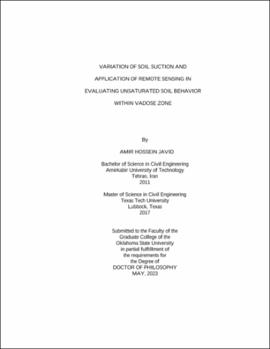| dc.contributor.advisor | Bulut, Rifat | |
| dc.contributor.author | Javid, Amir Hossein | |
| dc.date.accessioned | 2023-08-30T19:45:08Z | |
| dc.date.available | 2023-08-30T19:45:08Z | |
| dc.date.issued | 2023-05 | |
| dc.identifier.uri | https://hdl.handle.net/11244/339015 | |
| dc.description.abstract | Moisture movement in pavements and road embankments is receiving more attention in pavement and geotechnical engineering. Water from rainfall is the primary source of moisture in soils. Following a rainstorm event, large quantities of moisture can be absorbed by the soil when the water migrates into the soil mass. The passage of moisture has an impact on the mechanical performance and functionality of the pavement infrastructure. When the pavement infrastructure is built on expansive soils, water flow can cause damage to pavements due to the swelling and shrinking of expansive soils through adsorption and desorption of moisture. Such damage can result in severe financial loss; in fact, the estimated yearly cost of damage from expanding soil problems is $2.3 billion in the United States. Oklahoma contains large expanses of medium to highly expansive clays. The state's largest cities are located in these areas, and significant and costly highway systems have been built to support the population density. These areas have relatively high average annual precipitation, which worsens the expansive clay problems. The swelling or shrinking of expansive clays causes distortion and cracking in pavements, reducing pavement service life. Thus, it is critical to understand how water moves in road embankments of expansive soils subjected to seasonal rainfall and to predict the vertical movement of pavements built on expansive soils. This study used Oklahoma Mesonet measurements to develop a data-driven statistical model for estimating soil diffusivity and soil suction in order to predict the movement of expansive soils over time. The first component of the study used unsupervised learning and a nonlinear least squares model to estimate soil diffusivity. The second component of the study presents a mechanistic-numerical model for predicting equilibrium suction that considers the diffusion coefficient's effects and uses surface field suction measurements. The final component of the study utilized Interferometric Synthetic Aperture Radar (InSAR) technique for effective displacement monitoring using time series of SAR data. The study investigated the performance of moisture barriers on two state highways in Oklahoma, where expansive soils are a major problem. | |
| dc.format | application/pdf | |
| dc.language | en_US | |
| dc.rights | Copyright is held by the author who has granted the Oklahoma State University Library the non-exclusive right to share this material in its institutional repository. Contact Digital Library Services at lib-dls@okstate.edu or 405-744-9161 for the permission policy on the use, reproduction or distribution of this material. | |
| dc.title | Variation of soil suction and application of remote sensing in evaluating unsaturated soil behavior within vadose zone | |
| dc.contributor.committeeMember | Soliman, Mohamed | |
| dc.contributor.committeeMember | Wilber, Gregory | |
| dc.contributor.committeeMember | San, Omer | |
| osu.filename | Javid_okstate_0664D_18015.pdf | |
| osu.accesstype | Open Access | |
| dc.type.genre | Dissertation | |
| dc.type.material | Text | |
| dc.subject.keywords | equilibrium suction | |
| dc.subject.keywords | highways and roads | |
| dc.subject.keywords | remote sensing | |
| dc.subject.keywords | statistical analysis | |
| dc.subject.keywords | subgrade soil | |
| dc.subject.keywords | unsaturated soil | |
| thesis.degree.discipline | Civil Engineering | |
| thesis.degree.grantor | Oklahoma State University | |
